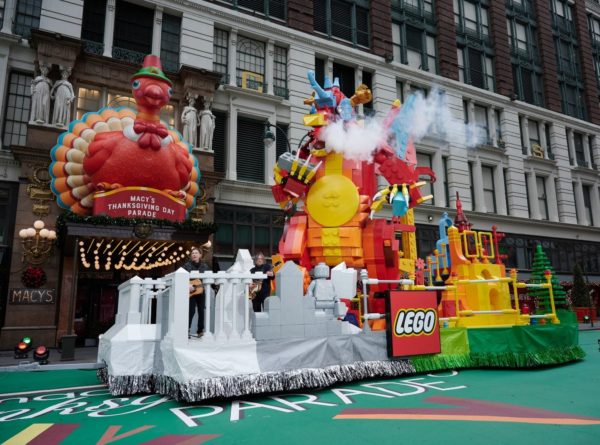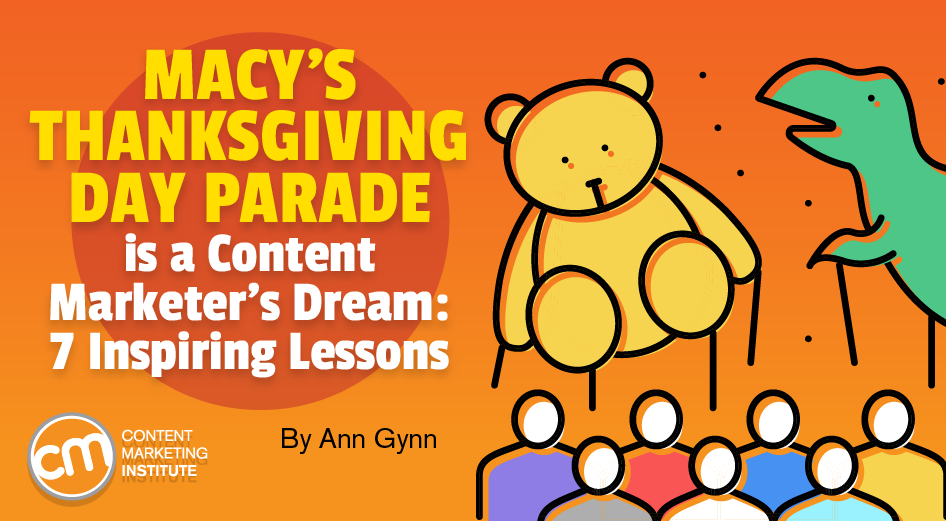Updated Nov. 22, 2022
Millions gather to view your content marketing on their screens.
Crowds line up over two miles just to get a glimpse of your content in real life.
That’s the stuff of content marketers’ dreams. And it’s the reality for marketers at Macy’s, the U.S. department store chain that has put on a parade in New York City every Thanksgiving since 1924.
I’m a big fan of Macy’s Thanksgiving Day Parade. I traveled to see it twice, and I never miss watching it on television. And that’s before I realized it’s all content marketing. Here are some lessons that struck me.
1. Steal ideas – just make them better
Macy’s wasn’t the first department store to host a parade as a content marketing tool for the Christmas buying season. In 1920, the Gimbel Brothers department store in Philadelphia created the first one. Four years later – the same year Macy’s launched its parade – the J.L. Hudson Co. department store started one in Detroit. Though those parades continue today, Gimbels and Hudson’s haven’t been involved for decades. Hudson’s ceased its parade connection when it closed its Detroit flagship in the late 1970s. (The chain was later bought by Macy’s). And the Philadelphia department store was liquidated in the mid-1980s.
Original ideas are hard to come by (some say there aren’t any). Don’t spend all your time trying to create something no one’s done. Look for existing inspiration. You may find content that isn’t living up to its potential – and then you can take the opportunity to do it better.
You don’t need original ideas. Just do existing ones better. That’s what @Macys did in creating its New York Thanksgiving Day parade, says @AnnGynn via @CMIContent. #ContentMarketing Click To Tweet2. Stick with what works, adjust what doesn’t
The first Macy’s Thanksgiving Day Parade stretched over six miles and featured nursery rhyme characters, store employees dressed as clowns and cowboys, and animals from the Central Park Zoo. A float carrying Santa and a reindeer-pulled sleigh closed the parade.
In the 21st century, the parade traverses only 2.5 miles to ensure a tighter show. It features multi-story-tall balloons that long ago replaced the zoo animals. It welcomes brands other than Macy’s into the act (think Pillsbury Dough Boy and Ronald McDonald). Marching bands from around the country, floats featuring lip-syncing celebrities, and live characters like the gang from Sesame Street expand the appeal.
Santa’s sleigh and reindeer are far more elaborate now, but the jolly fella retains his almost 100-year-old place in the parade – the final act anticipated by young and old.
When you have an enduring content star, go ahead and tweak it. Don’t use the same old, same old content all the time. Each year, Macy’s creates a curiosity gap: What new balloons will debut? Which will be retired?
@Macys creates a curiosity gap every year as audiences wonder what new balloons will debut and which will be retired, says @AnnGynn via @CMIContent. Click To TweetWhat annual content can you create that entices your audience to return again and again? At CMI, for example, we create content marketing research reports every year. Some of the questions in the research questionnaire remain the same each year, but we add new ones based on our audience’s needs, industry trends, and global changes.
Think about how to freshen up your content by adding new ideas or trying different formats.
Think about how to freshen up your #content by adding new ideas or trying different formats, says @AnnGynn via @CMIContent. Click To TweetFor example, a B2B brand might add a new department focused on remote work to its quarterly magazine. A B2C brand might shoot short, tip-focused videos based on information from blog articles.
The opportunities to adjust your content mix – topic, format, etc. – are endless.
3. Look at things from a different perspective
Let’s get to the truth. Despite the name (and the turkey float), the Macy’s Thanksgiving Day Parade has little to do with Thanksgiving. It’s really about the shopping season leading up to the biggest gift-giving occasions of the year. The floats, balloons, and songs all revolve around the red-and-green holiday. In fact, the event’s initial name was Macy’s Christmas Parade. Macy’s, as a business, isn’t focused on the Thanksgiving holiday. Macy’s cares about the timing of Thanksgiving – a month or so before the gift exchanges begin.
Think about traditional events or activities in your industry. How can you create content that turns them on their head? Let’s say your company has a booth at the same trade show every September. Instead of crafting another evergreen white paper to showcase your thought leadership, use the event as the exclusive release site for a must-have report on industry predictions for the coming year. Make that report the center of your content hub for the quarter, giving it life far beyond the two-day event.
4. Don’t go solo
Macy’s isn’t the only brand involved in the parade. McDonald’s sends up a Ronald McDonald balloon accompanied by his giant shoe car on the ground. Kraft’s Kool-Aid Man crashed the party for many years. Jennie-O’s Big Turkey Spectacular, Dreamworks’ Boss Baby, and Sinclair Oil’s baby dinos participate this year. And brands like Olay, Entenmann’s, Wonder Bread, and Lego host floats. Each branded parade entry is an example of sponsored content.

If a sponsored content model doesn’t fit your organization’s content strategy, you can still find ways to connect with other companies. For example, accept guest blogs on your site or craft guest content for non-competing brands that have similar target audiences.
5. Interact with your audience
In 2020, Macy’s used its Twitter account to engage with its audience before and during the parade. In addition to previewing that year’s attractions, Macy’s conducted a series of promoted tweets (that’s how they found me, though I didn’t remember to save one to share here). The tweet said Macy’s would send me a reminder about the parade if I picked my favorite parade activity and tweeted about it.
So I did:
Hi, @macys! I can’t wait to see the #MacysParade #balloons. What about you?
— Ann Gynn (@anngynn) November 23, 2020
Two hours before the parade started, I got this personalized reminder tweet:
@anngynn,
Happy Thanksgiving! 🦃
Don’t forget to turn on NBC at 9am to catch this year’s #MacysParade. pic.twitter.com/OCJV02rMQ3— Macy’s (@Macys) November 26, 2020
When you try to engage your audience members on Twitter, think about inviting them into your account or brand. That requires more than clicking a heart or retweeting. Make it personal. Give them something fun or valuable to share. Follow up with more personalized content.
6. Scrutinize your language
While I liked Macy’s approach to personalizing Twitter that year, I wasn’t a fan of its use of the word “diverse” in a 2020 tweet intended to celebrate Zeta Phi Beta, a Black sorority celebrating 100 years and making its first appearance in the parade:
TheJasmineBRAND grabbed the tweet before Macy’s removed it a couple of hours after it caused an outcry:
#ZetaPhiBeta referred to as a “diverse dance group” at the #macysthanksgivingdayparade 👀 pic.twitter.com/0ay1HQPAVy
— theJasmineBRAND (@thejasminebrand) November 26, 2020
Poor, wrong, or ignorant word choices eliminate any value your content might have had and can hurt the brand. Proofread your content not only for spelling and grammar but also for intent, interpretation, inclusivity, and so on. Macy’s misstep also teaches another writing lesson – creating inclusive and diverse content usually doesn’t require you to point out that it’s diverse and inclusive.
Creating inclusive and diverse #content usually doesn’t require you to point out that it’s diverse and inclusive, says @AnnGynn via @CMIContent. Click To Tweet7. Start small
Macy’s didn’t set up a grandiose event in 1924. The parade entries covered only two blocks and included about 50 people. But that was enough to enthrall tens, if not hundreds of thousands, to show up along the six-mile route. Though the media barely covered the event, the audience response prompted Macy’s to announce a few weeks later that the parade would return the next year. (It wasn’t until the parade made its television debut almost 30 years later that Macy’s got national attention and drew in millions more fans.)
What are your content marketing dreams (i.e., big goals)? They may seem overly ambitious, but is there a minimum viable content product you could really create that might lead to making those dreams come true? Start planning today.
HANDPICKED RELATED CONTENT:
Cover image by Joseph Kalinowski/Content Marketing Institute

